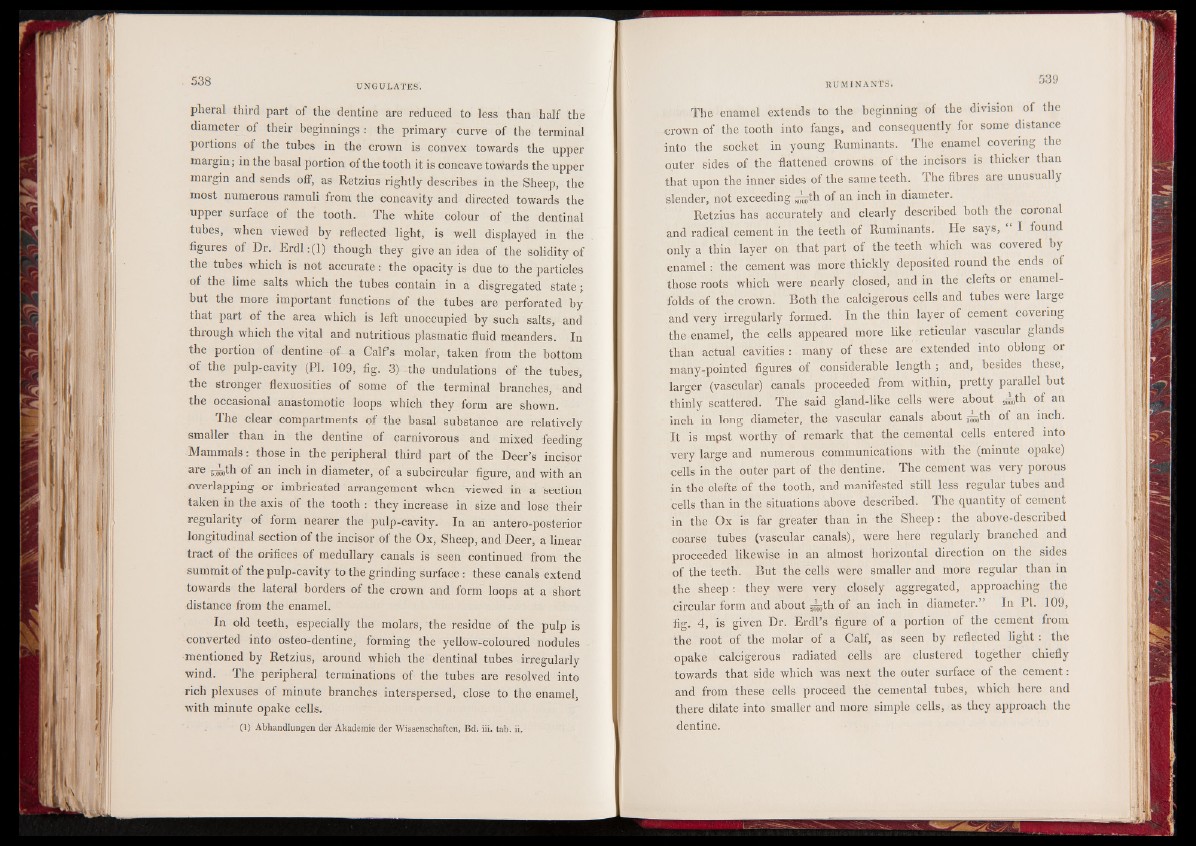
pheral third part of the dentine are reduced to less than half the
diameter of their beginnings : the primary curve of the terminal
portions of the tubes in the crown is convex towards the upper
margin; in the basal portion of the tooth it is concave towards the upper
margin and sends off, as Retzius rightly describes in the Sheep, the
most numerous ramuli from the concavity and directed towards the
upper surface of the tooth. The white colour of the dentinal
tubes, when viewed by reflected light, is well displayed in the
figures of Dr. Erdl:(l) though they give an idea of the solidity of
the tubes which is not accurate | the opacity is due to the particles
of the lime salts which the tubes contain in a disgregated state;
but the more important functions of the tubes are perforated by
that part of the area which is left unoccupied by such salts, and
through which the vital and nutritious plasmatic fluid meanders. In
the portion of dentine -of a Calf’s molar, taken from the bottom
of the pulp-cavity (PI. 109, fig. 3) the undulations of the tubes,
the stronger flexuosities of some of the terminal branches, and
the occasional anastomotic loops which they form are shown.
The clear compartments of the basal substance are relatively
smaller than in the dentine of carnivorous and mixed feeding
Mammals: those in the peripheral third part of the Deer’s incisor
are 5S)fh of an inch in diameter, of a subcircular figure, and with an
overlapping or imbricated arrangement when viewed in a section
taken in the axis of the tooth : they increase in size and lose their
regularity of form nearer the pulp-cavity. In an antero-posterior
longitudinal section of the incisor of the Ox, Sheep, and Deer, a lineal-
tract of the orifices of medullary canals is seen continued from the
summit of the pulp-cavity to the grinding surface : these canals extend
towards the lateral borders of the crown and form loops at a short
distance from the enamel.
In old teeth, especially the molars, the residue of the pulp is
converted into osteo-dentine, forming the yellow-coloured nodules
mentioned by Retzius, around which the dentinal tubes irregularly
wind. The peripheral terminations of the tubes are resolved into
rich plexuses of minute branches interspersed, close to the enamel;
with minute opake cells.
(1) Abhandlungen der Akademie der Wissenschaften, Bd, iii. tab. ii.
The enamel extends to the beginning of the division of the
crown of the tooth into fangs, and consequently for some distance
into the socket in young Ruminants. The enamel covering the
outer sides of the flattened crowns of the incisors is thicker than
that upon the inner sides of the same teeth. The fibres are unusually
slender, not exceeding j^jth of an inch in diameter.
Retzius has accurately and clearly described both the coronal
and radical cement in the teeth of Ruminants. He says, I found
only a thin layer on that part of the teeth which was covered by
enamel: the cement was more thickly deposited round the ends of
those roots which were nearly closed, and in the clefts or enamel-
folds of the crown. Both the calcigerous cells and tubes were large
and very irregularly formed. In the thin layer of cement covering
the enamel, the cells appeared more like reticular vascular glands
than actual cavities : many of these are extended into oblong or
many-pointed figures of considerable length ; and, besides these,
larger (vascular) canals proceeded from within, pretty parallel but
thinly scattered. The said gland-like cells were about 2«ioth of an
inch in long diameter, the vascular canals about ioobth of an inch.
It is mpst worthy of remark that the cemental cells entered into
very large and numerous communications with the (minute opake)
cells in the outer part of the dentine. The cement was very porous
in the clefts of the tooth, and manifested still less regular tubes and
cells than in the situations above described. The quantity of cement
in the Ox is far greater than in the Sheep: the above-described
coarse tubes (vascular canals), were here regularly branched and
proceeded likewise in an almost horizontal direction on the sides
of the teeth. But the cells were smaller and more regular than in
the sheep: they were very closely aggregated, approaching the
circular form and about a®th of an inch in diameter.” In PI. 109,
fig. 4, is given Dr. Erdl’s figure of a portion of the cement from
the root of the molar of a Calf, as seen by reflected light: the
opake calcigerous radiated cells are clustered together chiefly
towards that side which was next the outer surface of the cement:
and from these cells proceed the cemental tubes, which here and
there dilate into smaller and more simple cells, as they approach the
dentine.